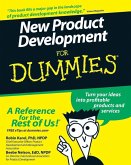Over the past decade, many companies in the semiconductor and aerospace industries have significantly upgraded their new product development processes, with disciplined timelines, strict design reviews, 'gates' to decision making and cross-functional collaboration. Some companies are outperforming their industry peers in terms of time-to-market and meeting customer needs. This raises the question of how companies can achieve and sustain performance based on the new product development function. To answer this question the present book analyzes the new product development process with a focus on the underlying dynamic capabilities, how such routines evolve on different organizational levels, and what are the associated social phenomena. Comparative case study evidence suggests that higher order resource reconfiguration and integration routines are established idiosyncratically. It is argued that simple, perception-based and loosely-coupled routines seem to be more effective for reconfiguring responsibilities and task sequences. On the other hand, detailed, codified and rigid higher-order routines were found more effective for integrating personnel, outsourced services and new technology.
Dieser Download kann aus rechtlichen Gründen nur mit Rechnungsadresse in A, B, BG, CY, CZ, D, DK, EW, E, FIN, F, GR, H, IRL, I, LT, L, LR, M, NL, PL, P, R, S, SLO, SK ausgeliefert werden.









